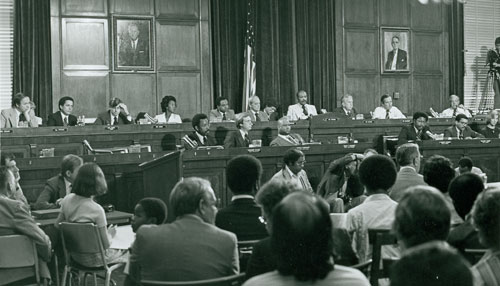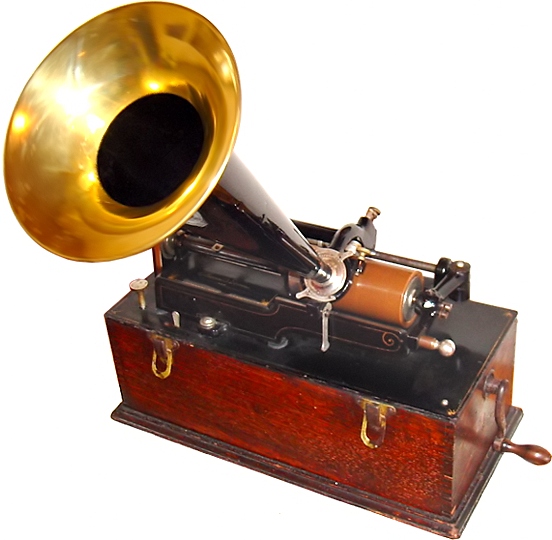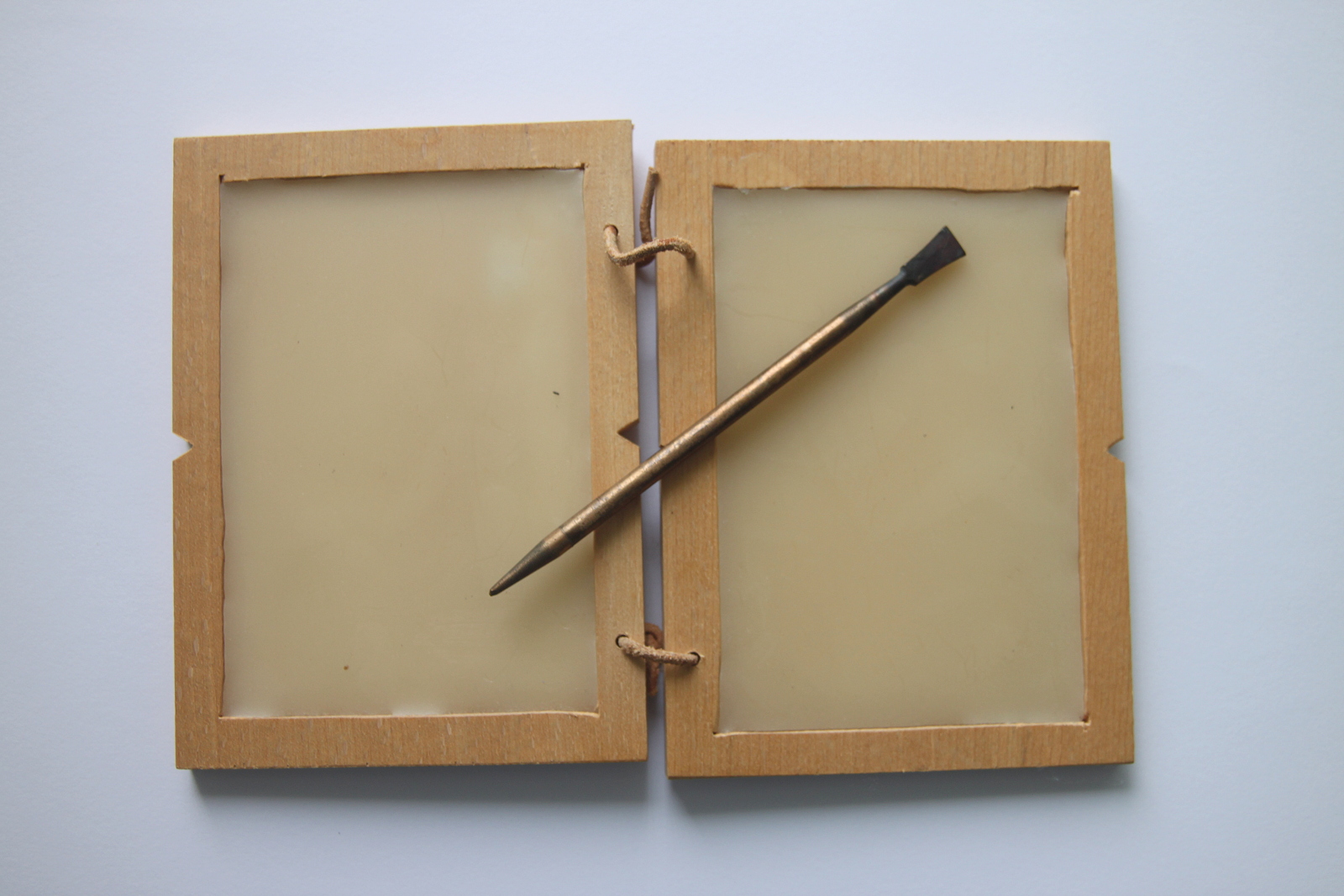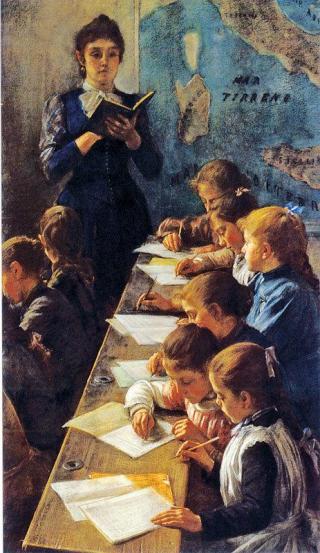|
Dictabelt
The Dictabelt, in early years and much less commonly also called a Memobelt, is an analog audio recording medium commercially introduced by the American Dictaphone company in 1947. Having been intended for recording dictation and other speech for later transcription, it is a write-once-read-many medium consisting of a thick transparent vinyl (according to a 1960s Dictaphone user manual: cellulose acetate butyrate) plastic belt wide and around. The belt is loaded onto a pair of metal cylinders, put under tension, then rotated like a tank tread. It is inscribed with an audio-signal-modulated helical groove by a stylus which is slowly moved across the rotating belt. Unlike the stylus of a record cutter, the Dictabelt stylus is blunt and in recording mode it simply impresses a groove into the plastic rather than engraving it and throwing off a thread of waste material. The Dictabelt system was popular, and by 1952, made up 90% of Dictaphone's sales. Dictabelts were more convenie ... [...More Info...] [...Related Items...] OR: [Wikipedia] [Google] [Baidu] |
United States House Select Committee On Assassinations
The United States House of Representatives Select Committee on Assassinations (HSCA) was established in 1976 to investigate the assassinations of John F. Kennedy and Martin Luther King, Jr. in 1963 and 1968, respectively. The HSCA completed its investigation in 1978 and issued its final report the following year, which concluded that Kennedy was probably assassinated as a result of a conspiracy. In addition to now-discredited acoustic analysis of a police channel dictabelt recording, the HSCA also commissioned numerous other scientific studies of assassination-related evidence that corroborate the Warren Commission's findings. The HSCA found that although the Commission and the different agencies and departments examining Kennedy's assassination performed in good faith and were thorough in their investigation of Lee Harvey Oswald, they performed with "varying degrees of competency" and the search for possible conspiracy was inadequate. The HSCA determined, based on available evid ... [...More Info...] [...Related Items...] OR: [Wikipedia] [Google] [Baidu] |
Phonograph Cylinder
Phonograph cylinders are the earliest commercial medium for recording and reproducing sound. Commonly known simply as "records" in their era of greatest popularity (c. 1896–1916), these hollow cylindrical objects have an audio recording engraved on the outside surface, which can be reproduced when they are played on a mechanical cylinder phonograph. In the 1910s, the competing disc record system triumphed in the marketplace to become the dominant commercial audio medium. Early development In December 1877, Thomas Edison and his team invented the phonograph using a thin sheet of tin foil wrapped around a hand-cranked, grooved metal cylinder. Tin foil was not a practical recording medium for either commercial or artistic purposes, and the crude hand-cranked phonograph was only marketed as a novelty, to little or no profit. Edison moved on to developing a practical incandescent electric light, and the next improvements to sound recording technology were made by others. Fo ... [...More Info...] [...Related Items...] OR: [Wikipedia] [Google] [Baidu] |
Dictation Machine
A dictation machine is a sound recording device most commonly used to record speech for playback or to be typed into print. It includes digital voice recorders and tape recorder. The name "Dictaphone" is a trademark of the company of the same name, but it has also become a common term for all dictation machines, as a genericized trademark. History Alexander Graham Bell and his two associates took Edison's tinfoil phonograph and modified it considerably to make it reproduce sound from wax instead of tinfoil. They began their work at Bell's Volta Laboratory in Washington, D.C.In 1879, and continued until they were granted basic patents in 1886 for recording in wax.Newville, Leslie JDevelopment of the Phonograph at Alexander Graham Bell's Volta Laboratory United States National Museum Bulletin, United States National Museum and the Museum of History and Technology, Washington, D.C., 1959, No. 218, Paper 5, pp.69-79. Retrieved from ProjectGutenberg.org. Thomas A. Edison had in ... [...More Info...] [...Related Items...] OR: [Wikipedia] [Google] [Baidu] |
Dictaphone
Dictaphone was an American company founded by Alexander Graham Bell that produced dictation machines. It is now a division of Nuance Communications, based in Burlington, Massachusetts. Although the name "Dictaphone" is a trademark, it has become genericized as a means to refer to any dictation machine. History The Volta Laboratory was established by Alexander Graham Bell in Washington, D.C. in 1881. When the Laboratory's sound recording inventions were sufficiently developed with the assistance of Charles Sumner Tainter and others, Bell and his associates created the Volta Graphophone Company, which later merged with the American Graphophone Company, which itself later evolved into Columbia Records. The name "Dictaphone" was trademarked by the Columbia Graphophone Company in 1907, which soon became the leading manufacturer of such devices. This perpetuated the use of wax cylinders for voice recording, which had otherwise been eclipsed by disc-based technology. Dictaphone ... [...More Info...] [...Related Items...] OR: [Wikipedia] [Google] [Baidu] |
Gray Audograph
The Gray Audograph was a dictation machine format introduced in 1945. It recorded sound by pressing grooves into soft vinyl discs, like the competing, but incompatible, SoundScriber. It was manufactured by the Gray Manufacturing Company of Hartford, Connecticut, in the United States. The Audograph recorded on thin vinyl discs, recording from the inside to the outside, the opposite of conventional gramophone records. Unlike conventional records, the disc was driven by a surface-mounted wheel. This meant that its recording and playback speed decreased toward the edge of the disc (like the Compact Disc and other digital formats), to keep a more constant linear velocity and to improve playing time. Along with a Dictabelt sound recorder, an Audograph captured sounds recorded at the time of the John F. Kennedy assassination that were reviewed by the United States House Select Committee on Assassinations. In 1950, Gray began to make a variant of the Audograph for AT&T AT&T Inc ... [...More Info...] [...Related Items...] OR: [Wikipedia] [Google] [Baidu] |
Audio Storage
Sound recording and reproduction is the electrical, Mechanical system, mechanical, electronic, or digital inscription and re-creation of sound waves, such as spoken voice, singing, instrumental music, or sound effects. The two main classes of sound recording technology are analog recording and digital recording. Sound recording is the transcription of invisible vibrations in air onto a storage medium such as a phonograph disc. The process is reversed in sound reproduction, and the variations stored on the medium are transformed back into sound waves. Acoustic analog recording is achieved by a microphone diaphragm that senses changes in atmospheric pressure caused by acoustics, acoustic sound waves and records them as a mechanical representation of the sound waves on a medium such as a phonograph record (in which a stylus cuts grooves on a record). In magnetic tape recording, the sound waves vibrate the microphone diaphragm and are converted into a varying electric current, wh ... [...More Info...] [...Related Items...] OR: [Wikipedia] [Google] [Baidu] |
Audiovisual Introductions In 1947
Audiovisual (AV) is electronic media possessing both a sound and a visual component, such as slide-tape presentations, films, television programs, corporate conferencing, church services, and live theater productions. Audiovisual service providers frequently offer web streaming, video conferencing, and live broadcast services. Computer-based audiovisual equipment is often used in education, with many schools and universities installing projection equipment and using interactive whiteboard technology. Components Aside from equipment installation, two significant elements of audiovisual are wiring and system control. If either of these components are faulty or missing, the system may not demonstrate optimal performance. Wiring is a skill that not only requires proper cable rating selection based on a number of factors, including distance to the main rack, frequency and fire codes, but wires should also be out of sight, behind the walls and in the ceiling, when possible. Sys ... [...More Info...] [...Related Items...] OR: [Wikipedia] [Google] [Baidu] |
John F
John is a common English name and surname: * John (given name) * John (surname) John may also refer to: New Testament Works * Gospel of John, a title often shortened to John * First Epistle of John, often shortened to 1 John * Second Epistle of John, often shortened to 2 John * Third Epistle of John, often shortened to 3 John People * John the Baptist (died c. AD 30), regarded as a prophet and the forerunner of Jesus Christ * John the Apostle (lived c. AD 30), one of the twelve apostles of Jesus * John the Evangelist, assigned author of the Fourth Gospel, once identified with the Apostle * John of Patmos, also known as John the Divine or John the Revelator, the author of the Book of Revelation, once identified with the Apostle * John the Presbyter, a figure either identified with or distinguished from the Apostle, the Evangelist and John of Patmos Other people with the given name Religious figures * John, father of Andrew the Apostle and Saint Peter * Pope Jo ... [...More Info...] [...Related Items...] OR: [Wikipedia] [Google] [Baidu] |
Virginia Circuit Court
The Virginia Circuit Courts are the state trial courts of general jurisdiction in the Commonwealth of Virginia. The Circuit Courts have jurisdiction to hear civil and criminal cases. For civil cases, the courts have authority to try cases with an amount in controversy of more than $4,500 and have exclusive original jurisdiction over claims for more than $25,000. In criminal matters, the Circuit Courts are the trial courts for all felony charges and for misdemeanors originally charged there. The Circuit Courts also have appellate jurisdiction for any case from the Virginia General District Courts (the trial courts of limited jurisdiction in Virginia) claiming more than $50, which are tried ''de novo'' in the Circuit Courts. The state has 120 courts divided among 31 judicial circuits. Judges of the Virginia Circuit Courts are appointed by the legislature, and serve an eight-year term, after which they may be reappointed. The only mandatory qualification for appointment as a Circuit ... [...More Info...] [...Related Items...] OR: [Wikipedia] [Google] [Baidu] |
Virginia
Virginia, officially the Commonwealth of Virginia, is a state in the Mid-Atlantic and Southeastern regions of the United States, between the Atlantic Coast and the Appalachian Mountains. The geography and climate of the Commonwealth are shaped by the Blue Ridge Mountains and the Chesapeake Bay, which provide habitat for much of its flora and fauna. The capital of the Commonwealth is Richmond; Virginia Beach is the most-populous city, and Fairfax County is the most-populous political subdivision. The Commonwealth's population was over 8.65million, with 36% of them living in the Baltimore–Washington metropolitan area. The area's history begins with several indigenous groups, including the Powhatan. In 1607, the London Company established the Colony of Virginia as the first permanent English colony in the New World. Virginia's state nickname, the Old Dominion, is a reference to this status. Slave labor and land acquired from displaced native tribes fueled the ... [...More Info...] [...Related Items...] OR: [Wikipedia] [Google] [Baidu] |
Stylus
A stylus (plural styli or styluses) is a writing utensil or a small tool for some other form of marking or shaping, for example, in pottery. It can also be a computer accessory that is used to assist in navigating or providing more precision when using touchscreens. It usually refers to a narrow elongated staff, similar to a modern ballpoint pen. Many styluses are heavily curved to be held more easily. Another widely used writing tool is the stylus used by blind users in conjunction with the slate for punching out the dots in Braille. Etymology The English word ''stylus'' has two plurals: ''styli'' and ''styluses''. The original Latin word was spelled ; the spelling ''stylus'' arose from an erroneous connection with Greek (), 'pillar'.''Oxford Latin Dictionary'', s.v. "stilus" (2012). The Latin word had several meanings, including "a long, sharply pointed piece of metal; the stem of a plant; a pointed instrument for incising letters; the stylus (as used in literary composi ... [...More Info...] [...Related Items...] OR: [Wikipedia] [Google] [Baidu] |
Dictation (exercise)
Dictation is the transcription of spoken text: one person who is "dictating" speaks and another who is "taking dictation" writes down the words as they are spoken. Among speakers of several languages, dictation is used as a test of language skill, similar to spelling bees in the English-speaking world. Secondary to teaching language skills, the exercise of dictation has also been used to introduce students to literary works, and to instill morals. Etymology It derives from Latin, ''dictare'' (to assert). Method The exercise requires at least two persons: a reciter and a recorder. The reciter reads a selected text, evenly and clearly and at audible volume, by snippets of multiple words (three to ten or as need be). The text is transcribed by the recorders, as the reciter proceeds. Each snippet is read by the reciter at first slowly, then repeated once or twice at a normal pace. Once the selection has been read to the end in this way, the reciter reads the text once again from ... [...More Info...] [...Related Items...] OR: [Wikipedia] [Google] [Baidu] |








